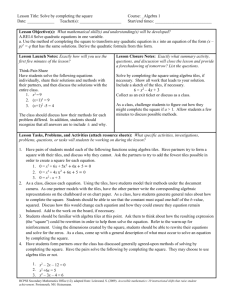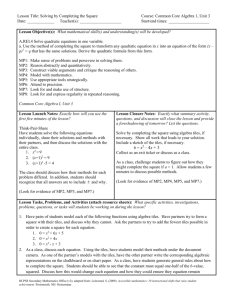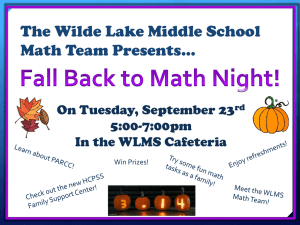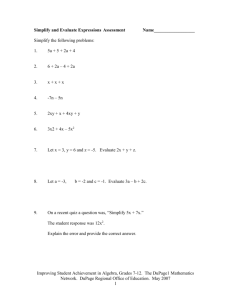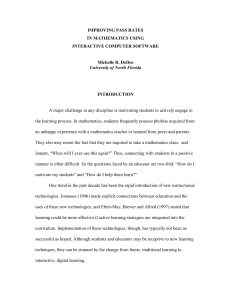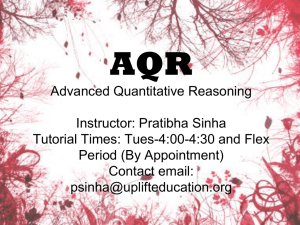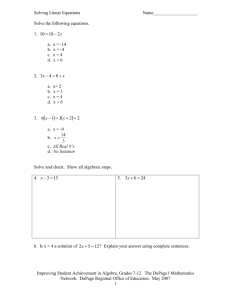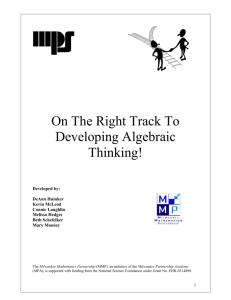Distributive Property - grade7commoncoremath
advertisement
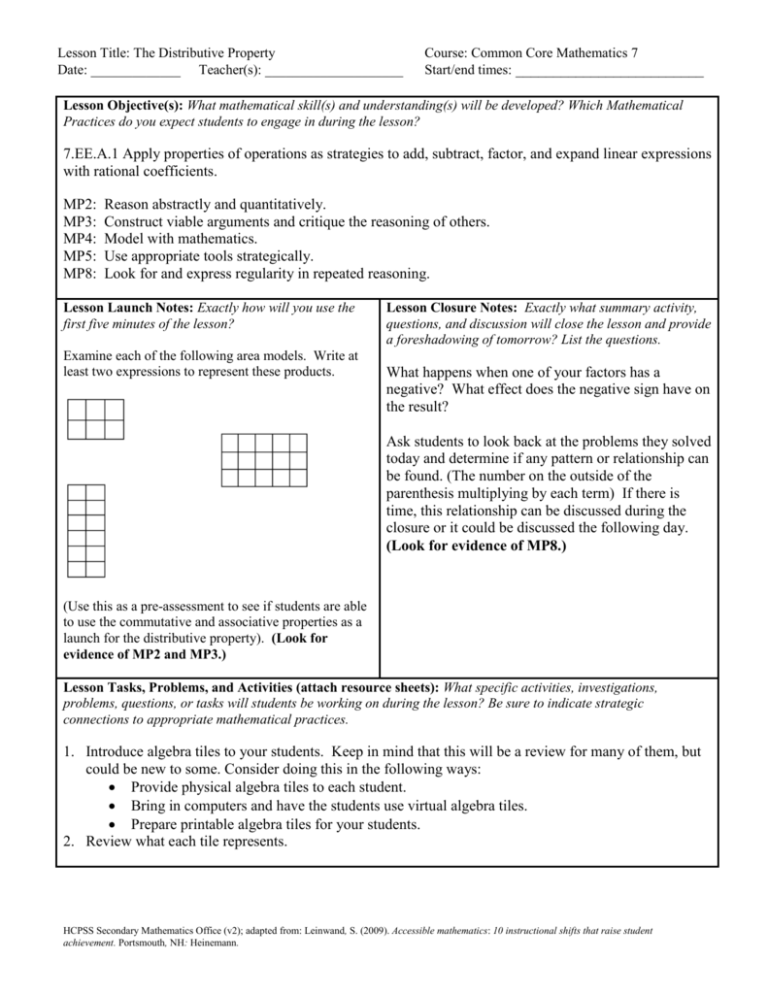
Lesson Title: The Distributive Property Date: _____________ Teacher(s): ____________________ Course: Common Core Mathematics 7 Start/end times: _________________________ Lesson Objective(s): What mathematical skill(s) and understanding(s) will be developed? Which Mathematical Practices do you expect students to engage in during the lesson? 7.EE.A.1 Apply properties of operations as strategies to add, subtract, factor, and expand linear expressions with rational coefficients. MP2: MP3: MP4: MP5: MP8: Reason abstractly and quantitatively. Construct viable arguments and critique the reasoning of others. Model with mathematics. Use appropriate tools strategically. Look for and express regularity in repeated reasoning. Lesson Launch Notes: Exactly how will you use the first five minutes of the lesson? Examine each of the following area models. Write at least two expressions to represent these products. Lesson Closure Notes: Exactly what summary activity, questions, and discussion will close the lesson and provide a foreshadowing of tomorrow? List the questions. What happens when one of your factors has a negative? What effect does the negative sign have on the result? Ask students to look back at the problems they solved today and determine if any pattern or relationship can be found. (The number on the outside of the parenthesis multiplying by each term) If there is time, this relationship can be discussed during the closure or it could be discussed the following day. (Look for evidence of MP8.) (Use this as a pre-assessment to see if students are able to use the commutative and associative properties as a launch for the distributive property). (Look for evidence of MP2 and MP3.) Lesson Tasks, Problems, and Activities (attach resource sheets): What specific activities, investigations, problems, questions, or tasks will students be working on during the lesson? Be sure to indicate strategic connections to appropriate mathematical practices. 1. Introduce algebra tiles to your students. Keep in mind that this will be a review for many of them, but could be new to some. Consider doing this in the following ways: Provide physical algebra tiles to each student. Bring in computers and have the students use virtual algebra tiles. Prepare printable algebra tiles for your students. 2. Review what each tile represents. HCPSS Secondary Mathematics Office (v2); adapted from: Leinwand, S. (2009). Accessible mathematics: 10 instructional shifts that raise student achievement. Portsmouth, NH: Heinemann. Lesson Title: The Distributive Property Date: _____________ Teacher(s): ____________________ Course: Common Core Mathematics 7 Start/end times: _________________________ (Michigan Virtual University, 2009) 3. Revisit the warm-up models. Show the expression 3(2+3). Have students identify which of the models can be represented with this expression. Have students explain that 3(2 + 3) is equivalent to 3 groups of 2 plus 3 groups of 3. Have students generate another equivalent expressions for this model (or one of the other models). 4. Explain that this property can be extended to expressions with variables by creating a similar area model. As a whole class and using the algebra tile mat, if you are using physical algebra tiles, have the students organize the following expression as seen below. (Look for evidence of MP4 and MP5.) 2(3x+1) (Michigan Virtual University, 2009) 5. Discuss the similarities between the way that you set up this expression and the ones in your warm-up. The students should notice that placing one factor across the top and one along the side makes the array. Ask the students to identify the two factors in the expression above. 6. Demonstrate how filling in the array results in the simplified expression. 6x + 2 (Michigan Virtual University, 2009) 7. Have students try additional examples in small groups, such as -3(x + 4). HCPSS Secondary Mathematics Office (v2); adapted from: Leinwand, S. (2009). Accessible mathematics: 10 instructional shifts that raise student achievement. Portsmouth, NH: Heinemann. Lesson Title: The Distributive Property Date: _____________ Teacher(s): ____________________ Course: Common Core Mathematics 7 Start/end times: _________________________ (Michigan Virtual University, 2009) Ask students to predict how the negative number will change the result. (Michigan Virtual University, 2009) 8. If your students are not prepared to complete similar problems independently, use the pass the problem expressions to continue practicing as a large group. Pass the Problem: Print the attached problems. Group the class into 6 groups and give each group one problem. Give them 2 min to create the answer on their algebra mat. After 2 min the groups will pass the problem to the next group and receive their next problem. 9. If your students are ready to work independently, use the following activities to offer them additional practice with building expressions. These activities can be used as whole group instruction or as centers depending on the level of independence that your students demonstrate. (Look for evidence of MP4 and MP8.) Matching: Create enough sets of the matching cards for each partner to have one set. With a partner have the students shuffle the cards and place them face down in an array. The object of the game is to create more matches than your partner. A match consists of the expression and its representation in algebra tiles. What’s My Expression: Put the students in partners. Round one: Player one creates an expression using algebra tiles while Player B factors it out. It is important that the student making the expression knows the answer so that they can tell their opponent whether or not they are correct. Round two: the roles are reversed. This time Player B creates the expression while Player A is to factor it out. HCPSS Secondary Mathematics Office (v2); adapted from: Leinwand, S. (2009). Accessible mathematics: 10 instructional shifts that raise student achievement. Portsmouth, NH: Heinemann. Lesson Title: The Distributive Property Date: _____________ Teacher(s): ____________________ Course: Common Core Mathematics 7 Start/end times: _________________________ Roll With It: This activity requires 4 dice (three regular number cubes and one number cube with three sides negative and three sides positive). The students roll the dice. One number rolled represents the first factor. The second number represents the coefficient within the parentheses and the third represents the constant of the second factor. If the 4th die rolled is a negative sign, the student much choose if they will make the first factor negative, the coefficient negative, or the constant negative. The student will then simplify the expression they created. Evidence of Success: What exactly do I expect students to be able to do by the end of the lesson, and how will I measure student success? That is, deliberate consideration of what performances will convince you (and any outside observer) that your students have developed a deepened and conceptual understanding. Students will be able to explain how to find the product of expressions. The teacher will measure understanding by circulating as students work through classroom activities and through class discussion. Notes and Nuances: Vocabulary, connections, common mistakes, typical misconceptions, etc. Key Vocabulary: factor, coefficient, constant, algebra tiles, distributive property Connections: Students will need to connect to their prior understanding of writing and solving equations from 6.EE.3 Misconceptions: The students may have some difficulty working with and understanding the algebra tiles. It will be important to reinforce the vocabulary throughout the lesson (especially coefficient, constant, and factor). Bibliography: Michigan Virtual University. (2009). Virtual algebra tiles: Multiplication. Retrieved from http://media.mivu.org/mvu_pd/a4a/homework/applets_multiplication.html Teacher Vision. (2012). Algebra tiles. Retrieved from http://www.teachervision.fen.com/algebra/printable/6192.html Math.com. (2005). Algebra worksheet generator. Retrieved from http://www.math.com/students/worksheet/algebra_sp.htm Resources: What materials or resources are essential for students to successfully complete the lesson tasks or activities? Homework: Exactly what follow-up homework tasks, problems, and/or exercises will be assigned upon the completion of the lesson? Copies of the Algebra Tile Mat Computers Virtual algebra tiles (Michigan Virtual University, 2009) Printable algebra tiles (Teacher Vision, 2012) Pass the Problem sheet Algebra tiles manipulatives 4 number cubes (3 marked with numbers 1-6 and 1 The teacher will determine the appropriate homework based on current student understanding. Consider: * Additional practice problems for students to solve using cutout algebra tiles or virtual ones. * If this is not discussed during the closure, ask students to reflect on any patterns they saw during HCPSS Secondary Mathematics Office (v2); adapted from: Leinwand, S. (2009). Accessible mathematics: 10 instructional shifts that raise student achievement. Portsmouth, NH: Heinemann. Lesson Title: The Distributive Property Date: _____________ Teacher(s): ____________________ with 3 sides marked with a negative sign and 3 sides marked with a positive sign) Course: Common Core Mathematics 7 Start/end times: _________________________ class today. Provide students with additional practice problems to allow them to model the relationship that exists between the number on the outside of the parenthesis and the terms on the inside. (MP3) Lesson Reflections: How do you know that you were effective? What questions, connected to the lesson standards/objectives and evidence of success, will you use to reflect on the effectiveness of this lesson Were my students able to create the expression accurately? Once they had the expression, were they able to work through possible ways to simplify it? Did I offer enough scaffolding while giving them enough room to develop their own understanding independently? Did I give my students the opportunity to persevere? Did my students’ homework assignment show understanding of the Distributive Property? Howard County Public Schools Office of Secondary Mathematics Curricular Projects has licensed this product under a Creative Commons Attribution-NonCommercial-NoDerivs 3.0 Unported License. HCPSS Secondary Mathematics Office (v2); adapted from: Leinwand, S. (2009). Accessible mathematics: 10 instructional shifts that raise student achievement. Portsmouth, NH: Heinemann.

